What is better to put in the kitchen: ceramic tiles or linoleum?
Choosing flooring material for the kitchen can be quite complicated. Many people want to show design talent and, for the sake of fashion, lay in the kitchen modern coatings: natural cork, self-leveling floors with an artistic print, etc. However, most of these materials are quite expensive pleasure, characterized by complex installation. In addition, it is still unknown how this or that new product will behave in the kitchen, where temperature and humidity regularly increase.
Therefore, the most far-sighted owners decide to lay in the kitchen time-tested materials: ceramic tiles or linoleum. Which of these coatings is better? Let’s try to understand this issue by comparing these two materials according to the most important criteria necessary in difficult kitchen conditions.
Content
Criterion # 1. Wear resistance
The kitchen is one of the most visited rooms in the house. According to some reports, a nimble housewife walks about 2 km in the kitchen per day! To withstand such loads, the floor must be as wear-resistant as possible. Otherwise, visible jammed spots and scratches will appear on it in a couple of months.
In general, the wear resistance of tiles is at a higher level than that of linoleum. In order for scratches and worn spots to appear on the ceramic surface, significant efforts must be made or the tile must be used for decades. Tiles are divided into several classes of wear resistance. For the kitchen, it is advisable to select material with markings of 3-5 classes.
Gradation of wear resistance exists in linoleums. Choosing a higher class linoleum, you can practically compare the wear resistance of linoleum and tiles.
Depending on the class, linoleums are divided into:
- household - classes 21-23;
- semi-commercial - classes 31-34;
- commercial - classes 41-43.
The household classes of linoleums are intended for residential premises, semi-commercial - for offices and various institutions, commercial - for industrial premises. However, all these divisions are rather arbitrary. "By the rules" for the kitchen are suitable household linoleums of class 22-23. But, to increase the durability of the coating, professionals recommend increasing the wear resistance class and choosing linoleum for the kitchen from the assortment of semi-commercial or commercial linoleums.
Criterion # 2. Moisture resistant
The second important requirement for coatings in the kitchen is moisture resistance. The fact is that here they periodically cook and wash dishes, respectively, the humidity is very high. Droplets of moisture in the air act on the floor surface and settle on it. Since water is constantly used in the kitchen, spilling it is a frequent occurrence.In other words, the flooring in the kitchen must withstand high humidity (in the form of condensation, standing puddles): do not swell, crack, do not deform.
Linoleum does not absorb liquid, so condensate, moist air and even spilled liquid will not harm it. However, if a flood occurs (for example, neighbors flood you from above) and water gets under linoleum, then deformation of the coating (bloating) is possible. Another prospect in this situation: the appearance of mold and fungal damage under wet linoleum. To prevent this, the coating will have to be removed and dried.
Moisture resistance of the tile is at a higher level. If we recall that even pools are tiled, then we can conclude that this material is absolutely moisture resistant. And even the flood and the bay neighbors will not do any harm to the tile!
Criterion # 3. Rich assortment
The assortment of linoleum and tiles in stores is simply huge. The variety applies to both types of coatings and their colors, textures, characteristics and features of operation.
There are two types of PVC linoleum: homogeneous and heterogeneous. Homogeneous is a single-layer layer of polyvinyl chloride with a pattern across the entire thickness, protected from above with a thin layer of transparent polyurethane. Heterogeneous linoleum is a multilayer material consisting of several layers of PVC, stabilizing fiberglass (fiberglass) and a protective transparent layer of vinyl and polyurethane. For the kitchen, you can use both types of PVC linoleum.
In addition to PVC rolls, on the market you can find (although much less often!) Natural linoleum - marmoleum. This is a completely natural material, in the manufacture of which a compressed mixture of linseed (or soy) oil, wood resin, crushed cork or wood flour, limestone is applied to the jute base. In addition to its naturalness, and therefore harmlessness, marmoleum has many other useful qualities that are not inherent in PVC linoleum. For example, antiseptic and fungicidal properties that protect the floor surface from the growth of harmful bacteria and fungi on it. Accordingly, marmoleum is very hygienic. Natural linoleum is also resistant to solvents, fats, ethyl alcohol, and non-concentrated acids. Everything else, it is fire resistant. Unfortunately, none of these qualities can be attributed to ordinary PVC linoleum. Its only winning feature is a lower price. The cost of some brands of marmoleum can reach the price of an elite parquet!
As for the coloring of linoleum, there is plenty to choose from: the full range of "pure colors"; marble coloring; various drawings; patterns imitating parquet, tile, leather, stone, etc. As a rule, these are heterogeneous synthetic linoleums. The range of colors of homogeneous linoleums is much more modest - it is either a plain color or marble blotch. Marmoleums, as a rule, are also monophonic or with patterns in the form of spots, stains. Sometimes there are collections that mimic other materials, such as crocodile skin.
Tiles do not lag behind the variety of linoleum. It can be matte and glossy, in different sizes and colors. Often its surface is decorated with drawings or patterns. Many modern collections consist of tiles, which when laid form one large pattern, for example, a poppy field or a panel of frolicking butterflies.
The ability of ceramic tiles to imitate other materials is unlimited. Tiles are produced almost indistinguishable from parquet, metal, fabric, genuine leather. Moreover, not only the pattern of these materials is imitated, but also the texture.
Criterion # 4. Impact resistance
Impact resistance is the strength of linoleum. If you drop a pot, glass or plate on it, nothing will happen to the coating. Linoleum will not break and will not crack.The only thing he is afraid of is sharp objects, such as knives or forks. Such items can leave punctures or cuts on the linoleum.
Tiles, on the contrary, are brittle. A heavy object such as a hammer falling on it is more likely to cause cracks and chips.
Criterion # 5. Resistance to mechanical stress
Linoleum is a material whose appearance is easily ruined by mechanical stress. On it remain cuts from fallen knives and forks, scratches from cat's claws or unsuccessfully moved furniture. Also, nowhere to get away from dents - traces of hairpins, legs of kitchen furniture and appliances. Therefore, when choosing linoleum, you need to pay attention to the thickness of its protective layer. The thicker it is, the more stable linoleum will be.
As for tiles, this material is more dense and solid, not changing its shape under the influence of external factors. Therefore, unlike linoleum, it is impossible to leave dents on the heels or legs of furniture on it.
Criterion # 6. Easy care, hygiene
Sometimes the floors in the kitchen have to be washed several times a day. Therefore, they are simply obliged to have dirt-repellent abilities and in no case to accumulate dust and garbage in themselves. Kitchen floors should require minimal maintenance to maintain cleanliness.
Caring for linoleum and tiles is not equally complicated. These materials are easily washed from household pollution. Dust, street debris, splashes of grease or household chemicals on them - everything remains on the surface. And to remove all unnecessary, just wash the floor and rub too dirty places with a soft rag. For the care of tiles and linoleum, there are lines of specialized products, but, in fact, the owners of floors from these materials wash them with plain water with the addition of any household cleaner.
It should be noted that in order to increase hygiene, some brands of PVC linoleums are impregnated with antibacterial and antifungal compounds. This does not mean that such material is self-cleaning, but the reproduction of bacteria and fungi that have fallen on it is significantly slowed down. Compared to artificial linoleum, marmoleum does not need any impregnation at all. It initially contains substances with bactericidal and fungicidal effects, that is, it is a kind of antiseptic.
Criterion # 7. Operational comfort
Linoleum is “warm” to the touch, it is pleasant to walk on it barefoot. Moreover, the thicker the material, the more heat it holds. The most comfortable linoleums in this regard with a backing are based on foamed PVC, jute or felt base. For wet kitchens, it is better to choose linoleums on a foam basis. Such a substrate is not afraid of water, unlike natural jute and felt.
The tile, on the contrary, has a cold surface, so walking in it in winter is not comfortable. There are two ways out of this situation. You can cover the cold floor with rugs and rugs. Or apply a more radical method - to lay under the tile system of a warm floor. When it is turned on, the temperature of the tile will be maintained in a framework that is comfortable for the person.
Criterion # 8. Compatibility with underfloor heating system
The tile has low thermal insulation properties, therefore it conducts thermal rays perfectly. The heating elements laid under the floor surface will transfer all their heat to the tile, and it, in turn, will transfer to the kitchen room.
The thermal insulation properties of linoleum are higher, in addition, PVC coatings are able to emit harmful substances when heated. Therefore, not every linoleum can be laid on top of water and electric underfloor heating systems. Permission to use a particular product is indicated on the packaging in the form of markings. So that linoleum in this case does not work as a heat insulator, thin material should be selected without an insulating substrate.
Criterion # 9. Resistance to heat
The tile is resistant to both heat and temperature extremes.Linoleum cannot be heated above 28-30 ° C. Therefore, when laying linoleum over a warm floor, it is necessary to equip the system with a thermostat. If the temperature regime is not observed, a change in the degree of coloration of the coating in the places of heating is possible. If something hot falls on a linoleum (a hot frying pan, for example), then its surface will melt and there will be unsightly traces.
Criterion # 10. Resistance to chemicals, aggressive media
By this criterion, of course, ceramic tiles lead. Grease stains or puddles of household chemicals used in the kitchen do not corrode the surface of the tile and do not change its color. Linoleum is much more moody. Aggressive substances falling on linoleum are poorly washed. Some of them (alkali, acid) are able to corrode the upper protective layer and leave stains, spots, bald spots.
Criterion # 11. Burn resistance
If linoleum is bedded in a sunny kitchen, after a couple of years you can notice a significant fading of its color and pattern. This marmoleum does not apply to marmoleum.
Unlike linoleum, tiles do not change color when exposed to intense sunlight. Not for nothing that some types of ceramic tiles (with increased frost and wear resistance) are used for cladding street objects - terraces, patios, outdoor areas.
Criterion # 12. Naturalness and environmental friendliness
Ceramic tiles are produced by pressing from kaolin clay with the addition of dyes. PVC linoleum is made from synthetic polyvinyl chloride. Marmoleum (natural linoleum) - from linseed oil and wood resin, fixed on a jute basis. In other words, tiles and marmoleum are natural and completely safe materials. Synthetic linoleum loses in this regard. It is especially unpleasant that it is capable of vaporizing polyvinyl chloride upon overheating.
Criterion # 13. Ease and speed of laying
The installation process of linoleum usually does not require the involvement of professional masters and is performed independently. In a standard kitchen, laying linoleum takes 1-2 hours.
Tiles are much more difficult to work with. To perform the installation of tiles, certain skills are required. Therefore, it is often attracted to these works by specialists who perform the lining of the kitchen floor, on average, for 1 day.
Criterion # 14. Price
Synthetic linoleum is one of the most inexpensive materials for the floor. This is its huge advantage over tiles. However, this applies only to artificial linoleums. Marmoleum is an expensive material and can give a head start at the price not only of tiles, but also of wooden parquet.
Conclusions - what is right for you?
As a result, we can conclude: both tile and linoleum are excellent for the kitchen. However, linoleum will almost certainly turn out to be a more budgetary and safer (not traumatic) option, although less durable. At the same time, when worn, it is easy to replace it with a new one. Tiles are expensive both at their own price and at installation cost. However, its use is longer. She longer than linoleum, retains its original appearance, less wear.
Therefore, choose the material that is right for you in specific conditions. In some cases, both options are combined. The working area, which is subjected to the greatest loads, is faced with tiles, and the dining area is covered with linoleum.

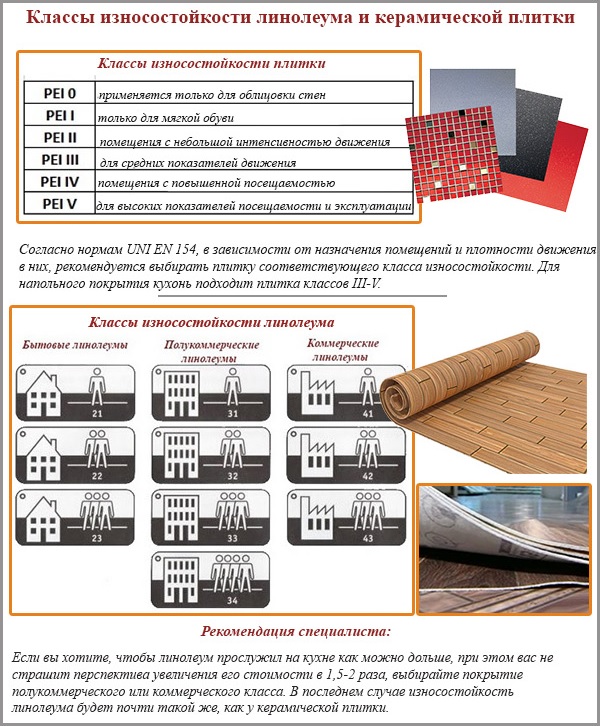
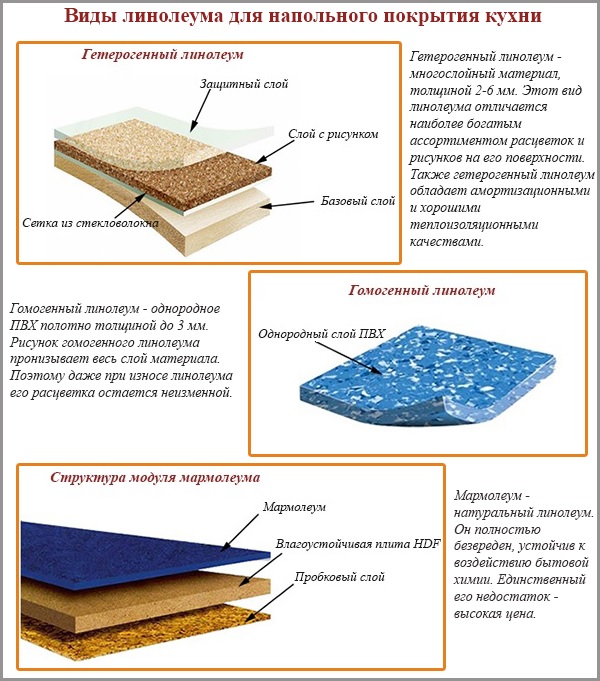
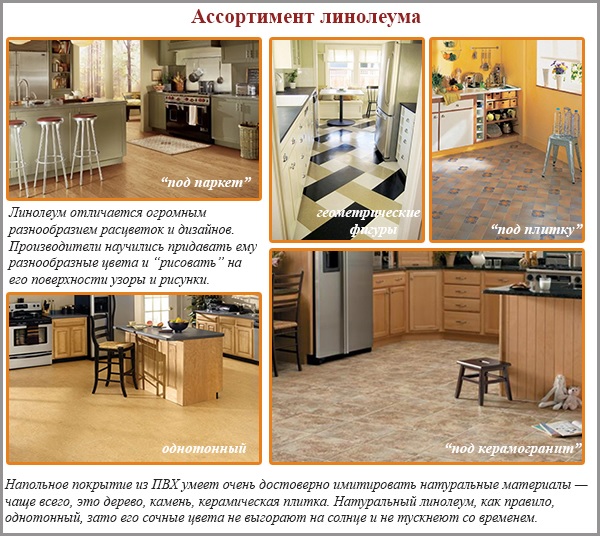
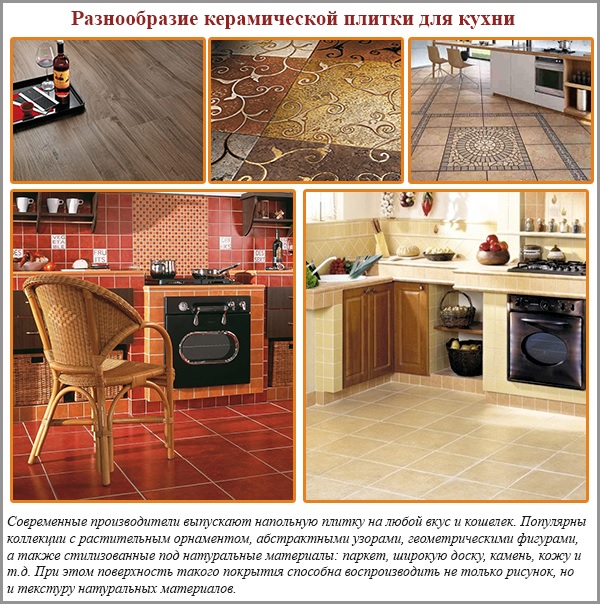
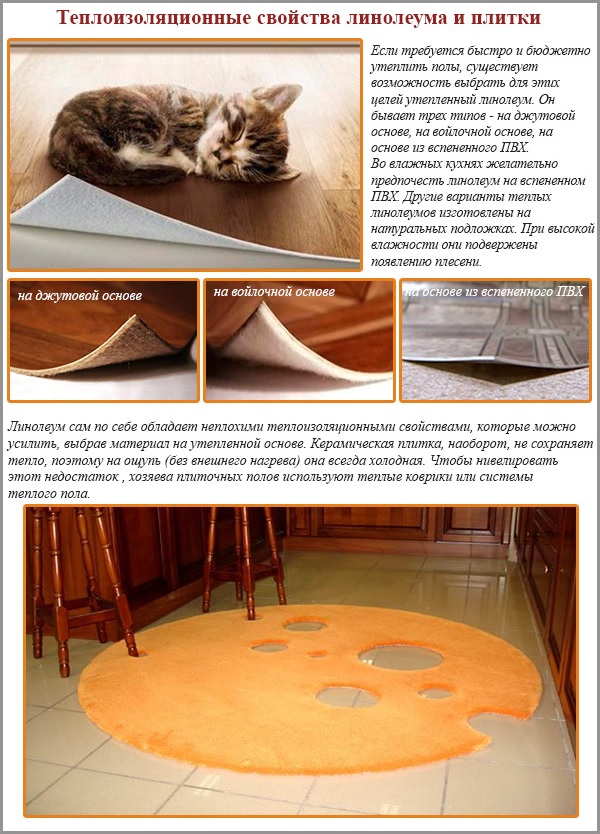


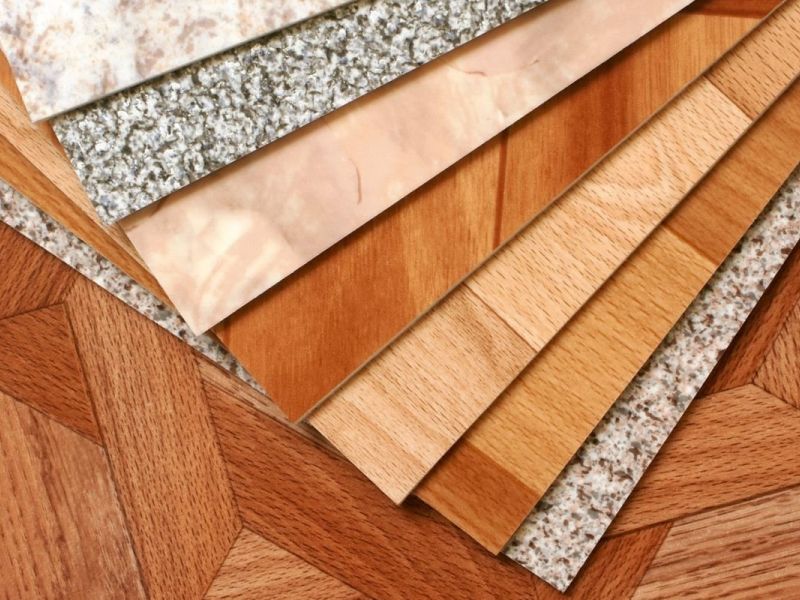
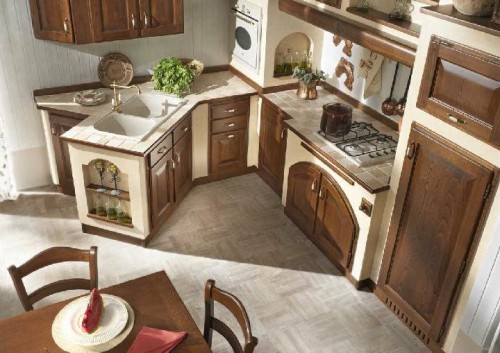

4 comments